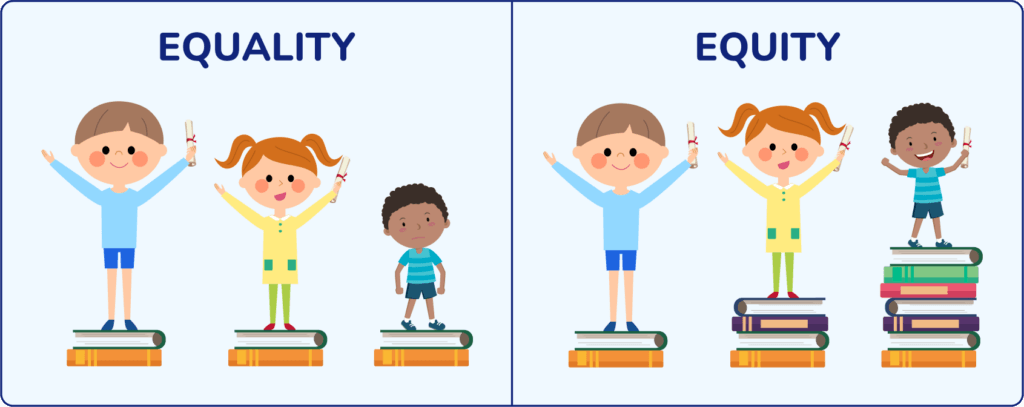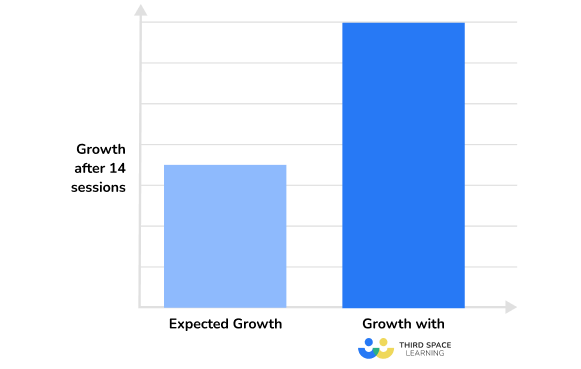Equity in Education: A Guide To Supporting Your Disadvantaged Students
Equity in education is rooted in the belief that all students deserve access to resources, opportunities and support within the education system that “level the playing field”, or give them the opportunity to perform as well as other students. It is a complex issue in American public education. Equity requires an understanding of systematic barriers that reduce access to resources and lead to poor outcomes for some students.
Promoting equity within a school or school system improves academic achievement, increases high school graduation rates and strengthens the overall community.
However, achieving equity doesn’t come without its challenges. This article will explore how continued efforts and strategic approaches within the classroom and a school can lead towards greater equity in education.
What is equity in education?
Equity in education is the principle that all students, regardless of their background or circumstances, deserve an equal opportunity to succeed within the education system.
Inequity in education originates from a complex series of social, economic and political factors that hinder access, opportunities and outcomes.
The achievement gap, largely attributed to inequity, is the disparities in educational performance or attainment between different groups of students. These groups can be categorized by:
- Race
- Ethnicity
- Socioeconomic status
- Gender
- Other demographic characteristics
Achievement gaps are most often found in standardized test scores, high school graduation rates, enrollment in advanced placement (AP) courses and college acceptance rates.
Socioeconomic status also plays a role in inequity. Students considered low-income often have less access to educational resources and access to supplementary support, such as tutoring.
Additionally, students born into low-income families are more likely to face food insecurity, housing instability and lack of access to healthcare, as well as face generational challenges such as parent education levels and access to educational opportunities.
Supporting Disadvantaged Students to Succeed in Math
All the practical steps you need to support disadvantaged students in your school succeed in math
Download Free Now!Equity vs equality in education
Equity and equality are often used interchangeably, which can be blamed on how similarly they are spelt and sound. Nonetheless, equity and equality are two different concepts.
Here’s what each concept is and how it may look inside your school environment.
Equity
What: Educational equity means creating an inclusive learning environment. Equity recognizes that not all students start from the same place and may require a different amount of support and resources to achieve equal outcomes.
Examples: Additional funding provided for low-income school districts, or targeted interventions for students with learning disabilities.
Equality
What: Equality in education refers to the idea of treating all students the same by providing them equal opportunities, resources and support.
Examples: All students receive the same math textbook in their class and the same amount of instruction time.
Having both equity and equality within a school and classroom is equally important. However, equity expands equality and provides access to tools and resources that allow all students the ability to succeed in learning and address underlying inconsistencies and individual needs.

Benefits of equity in education
Ensuring students have access to equity in education is crucial. There are many reasons why school leaders and teachers alike should try to attain education equity. Equity in education:
Prepares students for the wider world
When students have access to equitable educational opportunities, they gain lifelong skills.
The knowledge and experiences they gain prepare them for the ‘real world’, including critical thinking skills and empathy.
Improves learning outcomes for disadvantaged children
Equity in education aims to provide targeted support for struggling students. It also promotes the equal distribution of educational resources and support services. In turn, this gives disadvantaged students access to the tools and resources needed to succeed.
An independent study found that disadvantaged students receiving math tutoring from Third Space Learning made 7 months’ worth of progress in just 14 sessions.

Reduces bias later on in life
Students who are exposed to diverse perspectives and cultures can develop tolerance and respect for others.
Equitable education addresses systematic barriers, which then empowers students to challenge bias themselves in society.
Increases student engagement in lessons and promotes a love of learning
Schools that create an inclusive environment where students feel valued and respected tend to have increased student engagement and students who develop a love of learning.
When students are able to voice their interests, concerns and needs, teachers can tailor their instruction to meet individual needs and interests, making learning engaging and meaningful.
Challenges implementing equity in education
Understanding equity in education is just the starting point. There are still many barriers keeping public school systems from providing equity to all students.
Some of these barriers include:
- Lack of professional development
- Student vulnerabilities
- Pressures of standardized testing
- Implicit bias
- Stereotypes
- An overwhelming workload
The best way to overcome these challenges is to understand why they exist. Understanding the vulnerabilities that students may face, includes understanding:
- Socioeconomic disadvantage
- Racial and ethnic disparities
- English Language Learners (ELLs)
- Students with disabilities
While educators can’t solve these vulnerabilities within the classroom, they can take action to ensure that they meet students’ needs.
Resource allocation
School districts and administration must make decisions about how to use available resources (school funding, staff and time) to achieve a positive outcome for students. However, it’s equally important for teachers to make important decisions about time use within the classroom.
Provide high-quality education
A high-quality education includes instruction that not only challenges students to perform at grade level standards but also focuses on the social-emotional learning of students.
High-quality education is standards-based and focuses on what each child needs. This can also include any Response to Intervention that a child may need to fill gaps in understanding.
Extra academic support
Many tutoring strategies provide extra academic support to close the academic gap. A few examples include:
- After-school programs
- Peer tutoring
- Math tutoring
- Special education services
- Academic intervention programs
- High-dosage tutoring
Online tutoring programs allow teachers the flexibility to build in tutoring time as part of a multi-tiered system of supports within the school day.
Third Space Learning’s online tutoring aims to close the achievement gap and provide equity in education. Each session provides standards-aligned math tutoring for disadvantaged pupils that can be personalized for each individual student.
Tutors use error analysis to provide ongoing formative assessment for each student to adapt and personalize learning in real-time.
Schools can choose the timing, dosage and length of the tutoring session for each student to help provide equity in education for the students who need it most.
Strategies for achieving equity in education
Schools need to implement effective strategies to level the playing field for all students. This creates a fair and inclusive classroom environment for student learning.
Address students’ specific needs
Not all students are at the same level academically. Some will have special education needs, learning disabilities and those who just haven’t had a great learning experience since the COVID-19 pandemic.
Have a plan ready to address all these different needs to help you better prepare for all student needs.
Teachers and schools can use data to plan for students’ different needs and drive:
- Instruction within the classroom
- On-going professional development that addresses best practices and research based math interventions
- Development of personalized learning plans for students with specific needs and challenges, including learning disabilities
Build a supportive learning environment
Building classroom management strategies and a classroom culture that allows students to take risks and fosters an environment for learning is important. Students who feel comfortable and part of the classroom community are more likely to participate in classroom discussions. This can lead to a deeper understanding of learning standards.
Ensure students feel seen and heard, particularly those from vulnerable backgrounds.
Policies to promote equity
Policies play an important role in promoting equity in education as they address systemic barriers and allocate resources equitably. This ensures that all students have access to quality learning opportunities.
These policies can promote racial equity as well as support mental health initiatives.
Form partnerships between schools and community stakeholders
One of the most important partnerships that a school can secure is with members of the community. The phrase “It takes a village to raise a child” is used for a reason. It takes the whole community to support the needs and education of students.
Reach out to local community groups, churches and businesses to see how they can help support the needs of your students.
Ensure equal opportunities for student success
Providing equal opportunities for students means knowing your students and understanding their community.
- Advocate for your students’ rights and needs
- Assess your own assumptions and biases
- Differentiate instruction and assessment
- Personalize learning to student interests
Conclusion
Equity in education is essential for ensuring all students, regardless of their backgrounds, have fair and equal access to high-quality learning and appropriate support.
When equity in education is embraced, it creates inclusive learning environments and cultivates a more just and equitable society for generations to come.
Equity is not a classroom or school hour problem. Schools need to consider policies, initiatives, and interventions involving the community. Reach out to stakeholders and see how they are willing to support the great teaching and learning happening on campus.
Equity in Education FAQs
What does equity in education mean?
Equity in education means providing all students with support and resources they need to have a fair opportunity to be successful in their education journey. It takes the student as they are, takes into consideration any outside factors that may factor into their success, and provides whatever it takes to allow students to perform at their highest level.
What is an example of equity in a classroom?
An example of equity in the classroom would be providing additional academic support, such as additional math tools or graphic organizers, for a student who needed them. It can also be an Individualized Education Plan (IEP) for special education students.
What is the equity theory of education?
The equity theory of education is a psychological and sociological framework that examines how fairness and justice can affect students’ attitudes, behaviors, and academic outcomes within the education system. This theory examines how students’ perceptions of fairness and equity influence their attitudes towards learning, relationships with peers and school staff, and overall experience when it comes to school.



